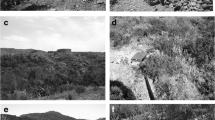Abstract
The aim of this study is to evaluate the impact of a drainage system on soil water conditions in a loam soil compared to that in undrained clay loam soil under various topographic conditions. The soils are located on a sloping area at Lidzbark Warminski experimental site (Poland) with well surface water outflow conditions and used as a pasture. The loam soil was drained with ceramic drainage pipes with an average drain spacing of 14 m and an average drain depth of 0.9 m, while the clay loam soil profile was not drained. The research was conducted during the period from 1999 to 2005. Ground water level as well as soil moisture content were measured monthly for both soil profiles. Meteorological conditions (precipitation and data for calculation of reference evapotranspiration) were also recorded. The results obtained show that in the loam soil (drained site) water level is on average 42 cm higher compared to that in the clay loam soil (not drained site). In both soils the amplitude of the ground water level changes was relatively high and exceeds 300 cm. In the drained loam soil, the water level position exceeded the depth of the drainage system in very wet, wet and average years. Under wet meteorological conditions the increase in ground water levels in the clay loam soil was slower than in the loam soil.
Similar content being viewed by others
References
Allen R.G., Pereira L.S., Raes D. & Smith M. 2000. Crop Evapotranspiration (guidelines for computing crop water requirements), FAO Irrigation and Drainage Paper No. 56, pp. 17–28.
Bos M.G. & Boers Th.M. 1994. Land Drainage: Why and How?, pp. 23–31. In: Ritzema H.P. (ed.), Drainage Principles and Application, International Institute for Land Reclamation and Improvement, Wageningen, The Netherlands.
Glossary of Soil Science Terms 1997. Soil Science Society of America, 134 pp.
Jasnowski M. & Ilnicki P. 1988. An examples of soil and vegetation transformation caused by water regime changes, pp. 437–443. In: Zasoby glebowe i roślinne, PWRiL, Warszawa. (In Polish)
Kaczorowska Z. 1962. The long term precipitation in Poland. Wydawnictwa Geologiczne. Prace geograficzne Nr 33, 72 pp. (In Polish)
Klute A. 1986. Water Retention: Laboratory Methods, pp. 635–660. In: Method of Soil Analysis, Part 1, Physical and Mineralogy Methods — Agronomy Monograph no. 9.
Kostrzewa S., Pływaczyk A., Peczkowski G. & Bogacz A. 1998. Water economy of light soils on the silts under conditions of controlled water runoff from draining system (on an example of study carried out in Barycz river valley). Zesz. Probl. Post. Nauk Roln. 458: 219–230. (In Polish)
Kozminski Cz. & Michalska B. 2005. The sunshine in Poland, Wyd. AR Szczecin, 110 pp. (In Polish)
Nowicka A., Banaszkiewicz B. & Grabowska K. 1994. The selected meteorological elements for Olsztyn region in 1951–1990 years with comparison to averages for 1881–1930 period. Mat. Konf. XXV zjazd agrometeorologow Olsztyn-Mierki: 129–135. (In Polish)
Plywaczyk A. & Peczkowski G. 1997. Preliminary research results of reaction of drainage system to water relations arable lands in Borzynowo object near Milicz. Roczniki Akademii Rolniczej w Poznaniu CCXCIV, Melioracje i Inzynieria Srodowiska cz. II: 251–260. (In Polish)
Skaggs R.W. & van Schilfgaarde J. 1999. Introduction, pp. 3–10. In: Skaggs R.W. & van Schilfgaarde (eds), Agricultural Drainage. No. 38 in the series Agronomy. ASA, CSSA, SSSA, Medison, Wisconsin,USA.
van Genuchten M. Th. 1980. A closed-form equation for predicting the hydraulic conductivity of unsaturated soils. Soil. Sci. Soc. Am. J. 44: 892–898.
van Genuchten M.Th., Leij F.J. & Yates S.R. 1991. The RETC Code for Quantifying the Hydraulic Functions of Unsaturated Soil. U.S. Salinity Laboratory, Department of Agriculture, Agricultural Research Service, Riverside, California 9250, 93 pp.
Wanke A. 2000. Functioning of systematic draining within clay soils in central Poland. Annales of Warsaw Agricultural University — SGGW, Land Reclamation 30: 99–107.
Zawadzki S. 1973. The laboratory determination of soil water retention abilities. Wiadomosci IMUZ. T. XI. z. 2:14–23. (In Polish)
Author information
Authors and Affiliations
Corresponding author
Rights and permissions
About this article
Cite this article
Szejba, D., Cymes, I., Szatylowicz, J. et al. An impact of drainage system on soil water conditions at Lidzbark Warminski experimental site. Biologia 64, 565–569 (2009). https://doi.org/10.2478/s11756-009-0110-y
Received:
Accepted:
Published:
Issue Date:
DOI: https://doi.org/10.2478/s11756-009-0110-y




